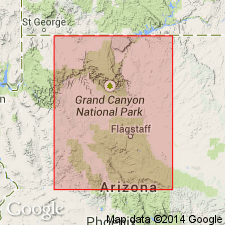
- Usage in publication:
-
- Gateway Canyon member
- Modifications:
-
- Original reference
- Biostratigraphic dating
- Dominant lithology:
-
- Limestone
- AAPG geologic province:
-
- Plateau sedimentary province
Summary:
Pg. 14 (fig. 1), 29, 105-109. Gateway Canyon member of Muav formation of Tonto group. At type locality, consists of thin beds of mottled, aphanitic limestone separated by parting planes of yellow-brown siltstone. Thickness 167 feet. Base determined by weak zone which everywhere forms bench at top of Kanab Canyon member. Upper limit indicated by flat-pebble conglomerate zone at bottom of overlying cliff. Westward from type locality to and beyond Granite Park, member fairly constant in character; beds become thicker, and silt partings less numerous, but total thickness remains about the same. From Diamond Creek westward, however, marker beds at base are absent, and member cannot be differentiated from lithologically similar underlying units. Eastward from Gateway Canyon, member is progressively less massive, contains more clastic materials, and is thinner bedded. Older than Havasu member (new); younger than Kanab Canyon member (new). Age is Middle Cambrian, based on fossils (trilobites, brachiopods, gastropods) identified by C.E. Resser. Report includes cross sections, measured sections, faunal list.
Type locality: at mouth of Gateway Canyon, south side of Colorado River opposite the Kanab Plateau, [Tuckup Canyon 15-min quadrangle, Mohave Co.], east-central Grand Canyon, northwestern AZ.
Source: US geologic names lexicon (USGS Bull. 1200, p. 1482); supplemental information from GNU records (USGS DDS-6; Menlo GNULEX, Denver GNULEX), GNC index card files.
For more information, please contact Nancy Stamm, Geologic Names Committee Secretary.
Asterisk (*) indicates published by U.S. Geological Survey authors.
"No current usage" (†) implies that a name has been abandoned or has fallen into disuse. Former usage and, if known, replacement name given in parentheses ( ).
Slash (/) indicates name conflicts with nomenclatural guidelines (CSN, 1933; ACSN, 1961, 1970; NACSN, 1983, 2005, 2021). May be explained within brackets ([ ]).

